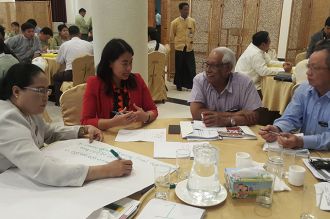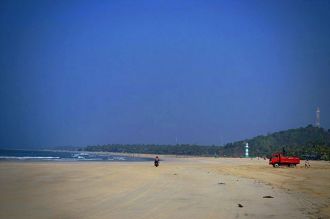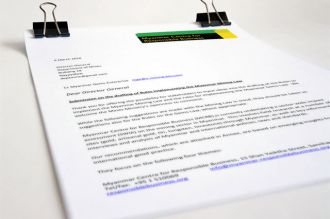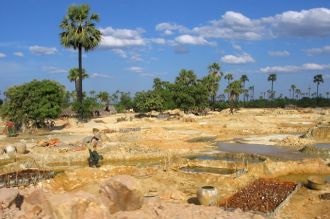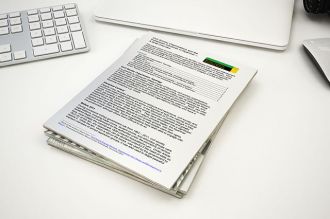Mining Sector
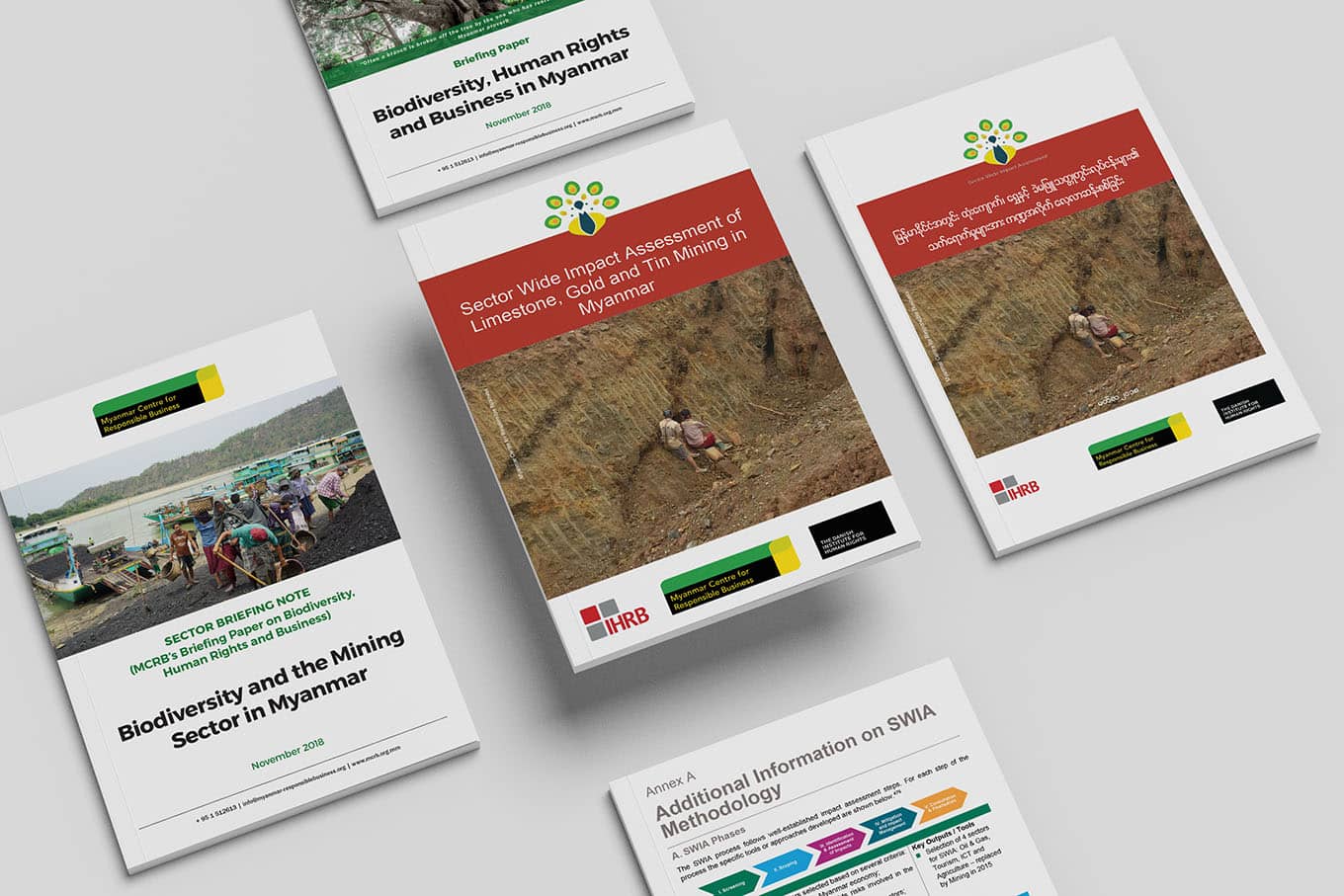
The Sector Wide Impact Assessment (SWIA) on Limestone, Gold and Tin Mining in Myanmar was the fourth and final full-scale SWIA undertaken by MCRB, with guidance from the Danish Institute for Human Rights (DIHR).
A SWIA is a forward-looking assessment that aims to contribute to preventing and minimising the sector’s negative impacts as well as strengthening and improving the sector’s positive impacts. The Mining SWIA analyses the impacts of mining of these three commodities on the environment, local communities and workers. It covers sector-wide, cumulative and project-level impacts, looking at both the formal and informal parts of the sector.
Initially it had been planned to conduct MCRB’s 4th SWIA on Agriculture. However, the decision to pursue a SWIA on mining was taken after engagement with environmental and human rights defenders consistently showed that mining was their chief concern. The legacy of the 2012 protests at the large scale Letpadaung copper mine continuing to reverberate, but individual and cumulative impacts at historical mining sites, and sites affected by artisanal mining, particularly of gold. Furthermore, mining activities are drivers of conflict in Myanmar, and the resolution of this through a federal mining framework is central to building peace. General conflict analysis based on field research findings was contained in Part 5.6 of the SWIA and Part 6 contained a Region-Specific Governance and Conflict Analysis focussed on Kachin, Shan State and South East Myanmar and the conflict dynamics and armed group involvement in mineral extraction in all of these areas.
Another reason for switching to mining included interest from international ‘junior’ companies in exploration in Myanmar, and the presence of Myanmar commodities, particularly tin, on global markets. This increased the potential leverage for improving practices.
Field research took place in 2016/2017 in eight areas throughout Myanmar, with two research sites for each commodity/topic (tin, limestone, large scale gold mining and artisanal gold mining. After consultation, the SWIA was published in March 2017.
inin
A supplement of ‘Linked Initiatives’ in the mining sector aimed to outline the initiatives relating to mining and human rights in Myanmar by government, development partners, business, and NGOs at the time of publication in 2017.
Drawing on the SWIA findings international standards, and follow-up multistakeholder discussions a Mining Sector Briefing Note was prepared as a supplement to MCRB’s series of 2018 publications on Biodiversity, Business and Human Rights.
The SWIA contained the usual recommendations to the Myanmar Government, businesses, civil society and other actors on how adverse impacts of the mining sector can be avoided and addressed, and how positive impacts can be maximised. However, the SWIA also sought to crystallise the dysfunctionality of the sector, both at the policy/law level, and the practice level, in comparison to sectors in the first three SWIAs (oil and gas, tourism and ICT) and the challenges underlying this, specifically:
- Policies, laws and regulations relevant to mining activities lack clarity and inhibit responsible investment
- The capacity of government and business actors to monitor and address environmental, social and human rights impacts of mining is limited
- The environmental, social and human rights costs of mining are externalised on local communities
- Governance of mining in conflict-affected areas is highly problematic
- Extensive informality in the mining sector needs to be addressed

In the SWIA, MCRB advocated for Myanmar to completely overhaul the sector, starting with a Mineral Resources Policy, rather than the approach of adoption of multiple laws and confusing and contradictory amendments, with a substandard retrofitted Policy (which was the approach being taken at the time of the coup).
The sector’s dysfunctionality was explored in a multistakeholder discussion in Monywa in March 2019 on gold mining in Sagaing which explored the contradictions between national and sub-national law, and between laws pursued different Ministries, as well as local community priorities.
As with the Oil and Gas SWIA, the Mining SWIA was preceded and followed up by other multistakeholder discussion and advocacy, mainly focussed on the emerging environmental and social impact assessment process, including public participation and draft sectoral EIA guidelines on mining (2018). Findings were also incorporated into advocacy on the draft Rules to implement the Mining Law (2016) reform of land laws, including land acquisition and resettlement.
There was general confusion at the level of legislators, regulators, company and communities about the difference between requiring a company to avoid, reduce and mitigate adverse/negative impacts, and the opportunity for mining to promote positive social impacts and community development such as local employment. MCRB regularly sought to distinguish between these two approaches, and how they related to the EIA process.

Fixing problems of transparency and environmental and social performance in the mining sector was one of the main civil society priorities that they pursued as part of Myanmar’s participation in the Extractives Industries Transparency Initiative (EITI). Although Myanmar was delisted from EITI in 2024, licence data from reports published between 2016 and 2020 is mapped here. Public participation, grievance handling and mediation of community conflicts with mining companies were all issues on which MCRB facilitated discussion, including with others working in the field such as Peace Nexus, Oxfam, Earthrights and World Wildlife Fund.
Others, particularly Global Witness, have published excellent research on conflict, human rights abuses and environmental destruction related to mining of jade and rare earths. To ensure that work undertaken in 2016/2017 by Coffey-Valentis with recommendations for more responsible and better planned jade mining practices was not lost as a result of non-publication, MCRB has also included these on its website.
Although not a commodity included in the SWIA, MCRB, in the course of its work on tourism, highlighted a number of issues relating to river, seabed and beach sand mining and conducted advocacy on this with national and local governments between 2015 and 2018.
The Mining SWIA also identified a role in Myanmar for international initiatives and standards such as the Voluntary Principles on Security and Human Rights. In 2018, an In-country Working group on the Voluntary Principles was established with MCRB as Secretariat. However, unlike oil and gas, Myanmar lacked the presence of international mining companies who are members of the Voluntary Principles Initiative, other than PanAust, who were at an early exploration stage. This made practical activity relevant to security in the mining sector challenging, despite an appetite to learn on the part of government ministries and civil society. dialogue on possible emerging regulation of private security companies which ultimately led to MCRB’s 2022 Baseline Assessment of Private Security Companies, which drew heavily on the work of ICoCA, the responsible security association, of which MCRB became a civil society member.
Following the coup, most remaining foreign mining exploration companies suspended their plans for exploration and possible investment. MCRB’s activity in the sector, including on the VPSHR, ended in February 2022.
Information about MCRB’s activity in the mining sector during the period 2013-2024:
Jade Mining in Kachin State – Environmental Management Plans
This Advisory Paper (in English and Myanmar) advises how to achieve safer and more environmentally friendly practices in the jade mining areas of Lonkhin and Hpakant in Kachin State, with suggestions for inclusion of yemasay/scavengers.
Towards Responsible Gold Mining in Sagaing Region
On 9/10 March, MCRB hosted a multi-stakeholder discussion on licensing and responsible business practices for gold mining in Sagaing Region. The purpose of the workshop was to support the action point 5.5.3 in the Government of Myanmar’s 2018 Myanmar...
Awareness-Raising Workshops Held in Yangon and Naypyidaw on the Voluntary Principles on Security and Human Rights (VPSHR)
Following on from the recommendations of the Scoping Report and the decision of the 18 May Myanmar Steering Committee of the VPSHR, two half-day awareness-raising workshops about the VPSHR and how they could be useful for Myanmar were held in Naypyidaw.
MCRB Presents Responsible Business Basics at the Mon State Parliament
On 13 July, Aung Kyaw Soe and Hlaing Min Oo of MCRB presented at the “Project Planning and Project Management in Financial Workshop” held at the Mon State Hluttaw Hall in Mawlamyine...
River Sand Extraction in Myanmar
Bethia Kadoe was attached for a month in 2017 as an intern with MCRB, and worked in collaboration with WWF to study river sand mining in the Ayeyarwady/Yangon area. This is her paper from her research.
Working with Community Groups in Shan State on Responsible Business and EIA
Hnin Wut Yee and Aung Kyaw Soe were speakers at a workshop in Taunggyi for civil society organizations on “Responsible Business and the Role of Environmental Impact Assessment (EIA)” on 7/8 June...
Experts object to firms’ plans to mine sand in Tanintharyi Region
A local company plans to extract 5 million cubic metres of sand over five years in sensitive coastal areas in Tanintharyi Region without legally-required environmental assessments.
Consultation Begins on Draft EIA Guidelines for the Mining Sector
The consultation was attended by over 100 participants, mainly from the mining sector, EIA consultants, and relevant government officials from MONREC (mining, environment and forestry), Ministry of Health and Sport and Ministry of Home Affairs.
A New Mineral Resources Policy and Fresh Laws are Needed if Mining in Myanmar is ever to be Sustainable
MCRB today publishes a sector-wide impact assessment (SWIA) on the mining sector, with field research focussed on tin, gold and limestone mining in eight states and regions. This is the fourth SWIA by MCRB.
Distinguish Between the Legal Obligations and Voluntary Efforts Needed for a Mine to Earn a ‘Social Licence to Operate’
From 24 to 26 October, MCRB collaborated with WWF Myanmar and the Ministry of Natural Resources and Environmental Conservation (MONREC) on a training workshop in Naypyidaw on Mining Sector Environmental and Social Impact Assessment and Management.
MCRB Discusses Beach Sand Mining in Ngwesaung with Pathein Township Officials
On 20 June, Vicky Bowman, Director, and Wai Phyo Myint, Regional Outreach Manager visited Pathein for a discussion of the problems of beach sand mining in Ngwesaung.
Findings from the Mining Sector-Wide Impact Assessment Presented in Geneva and KL
MCRB's Extractives Programme Manager presented findings from the Sector-Wide Impact Assessment (SWIA) of Mining in Myanmar and its main recommendations to the Asia Pacific Mineral Resource Exhibition and Conference (APMREC) 2016 in Kuala Lumpur, Malay
Consultation Meetings Held on the Mining Sector Wide Impact Assessment
On the 11 and 12 October Myanmar Centre for Responsible Business (MCRB) held two consultation meetings in Yangon to receive feedback and allow discussion on the draft Mining Sector Wide Impact Assessment (SWIA).
MCRB contributes to Australia-Myanmar Chamber of Commerce’s Good Governance in Mining Seminar in Nay Pyi Taw
The Seminar was focused on Australian best practice environmental and social impact solutions for the mining sector in Myanmar.
MCRB Inputs into the Consultation on Rules to Implement the Mining Law
MCRB has made a submission to the Ministry of Mines on the drafting of Rules implementing the Myanmar Mining Law.
Protecting Myanmar’s Coastal Tourism Potential - Ngapali & Beach Sand Mining
MCRB has submitted some ideas and suggestions to H.E. Vice-President U Nyan Tun, Chair of Myanmar’s Tourism Development Central Committee on how to address the threat that sand mining represents to Myanmar’s coastal beach tourism, particularly at Ngapali.
Amnesty International slams abusive, poorly regulated Myanmar mining industry
Amnesty International is calling for investigations by Canada and China into potential human rights abuses and illegal activity relating to the Monywa copper mining operation in Myanmar.
Community Engagement by Extractive Companies is Essential for Success in Myanmar
MCRB held a “Multi-Stakeholder Workshop on Community Engagement in the Extractives Industries” in Yangon on 27/28 January 2015 to discuss international best practice in strategic community investment and engagement, including how to handle grievances.
Briefing Paper on Civil Society Organisations and the Extractives Industries in Myanmar
MCRB has published a briefing paper on civil society organisations (CSOs) and the extractives industries in Myanmar which is intended to support meaningful engagement between companies and CSOs who are focussed on oil, gas and mining.
MCRB Contributes to USAID Training for Government Lawyers on including Environmental and Social Issues in Contracts
On 7 August, Vicky Bowman, MCRB Director, spoke to a group of around 40 government officials from the Union Attorney General’s Office, as well as officials from other ministries working on contracts including Mining, Energy and Electric Power.
 English
English မြန်မာ
မြန်မာ မြန်မာ (unicode)
မြန်မာ (unicode)


